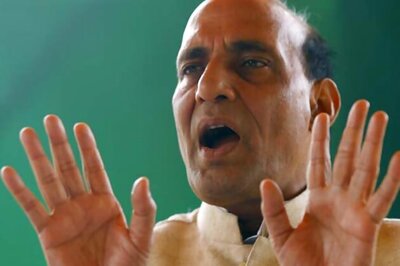
views
The fresh surge in daily infections of Covid-19 has led to demands that the central government ease restrictions and make vaccines more widely available to the Indian public, but AIIMS Director Dr Randeep Guleria says it would be wrong to give the vaccines to young people before the elderly, who are at higher risk of dying from the infection, are covered.
In a wide-ranging conversation with News18, Dr Guleria says that vaccination should continue in stages based on the priority groups formed by the government, and the focus should be on following Covid-19 appropriate behaviour, as well as testing, tracing, and isolating to curb the spread of the second wave of infections in the country.
Here are the excerpts of the conversation:
Q1. Given the vaccine wastage, is there a possibility that the government will open vaccination for all?
A. In an ideal situation, one would like to vaccinate all adults but one must understand that we must have enough doses. If you were to vaccinate everyone over the age of 18, that would be almost 90 crore people and that would mean we will need 2 billion doses because there are two doses that are required. That is not possible, and therefore, we have to do the vaccination in a phased manner keeping two basic principles in mind: the 1st is that we have to vaccinate those who have a higher chance of dying because of Covid-19, the higher risk group, and secondly, those who are front line workers, the healthcare workers or the others who are involved in the fight against Covid-19, because we don’t want to lose that force and they should be protected.
Once that is done, one will gradually open it up but we have to have enough doses to do that and that is why there is a priority list based on not only guidelines in India but international guidelines. The challenge is to reach out to more and more people so that we cover this group as early as possible, do it in a manner that there is no wastage and also do it in a manner that those who get left out because they are not tech-savvy or are not able to reach the vaccination site are accommodated for and also are taken care of.
Q 2. What about the 50-plus demographic? When does their turn come?
A. Once we reach the tipping point and we can say the majority of the elderly, those over the age of 60, have been vaccinated, and those who are in the high-risk group i.e. 45-59 with co-morbidities, have also received the vaccines. After that, I’m sure the government will take this step if they have enough doses. I am very hopeful that this should happen early rather than late. This is as per the initial guideline also, which was to vaccinate everyone over the age of 50, and those less than 50 with co-morbidities.
Q 3. What explains this high level of vaccine wastage – 6.5 per cent of all doses going waste is a huge number?
A. I think the states have to develop a strategy so that vaccines don’t go to waste. We must understand that vaccines come in vials that have 20 doses, so you have to develop a strategy so that you know how many vials to open. You may have a case at the end of the day as you open a vial and you have only one or two people who want to be vaccinated. Then if you vaccinate the two people, the remaining eight doses may get wasted. So a strategy needs to be developed at each level so there is a good balance between the number of vials that one opens and the number of people who come to get themselves vaccinated.
Remember that large number of people are coming as walk-ins, so you are not sure about the number of people who come as walk-ins. Therefore, one has to take a calculated risk, because you may have one person who walks in and you have to open a vial for him. Then you have to decide whether you should vaccinate him or not. Currently, everyone who comes is being vaccinated.
Q 4. Given the rate at which we are vaccinating, herd immunity could be 12 years away. Is developing herd immunity the only way to beat the virus?
A. I personally feel that it will take a really long time to achieve herd immunity. We may not be able to achieve it at all too, because we are currently assuming that the virus will remain the same for us to achieve herd immunity. The virus will keep on mutating, so there is a chance that the virus mutates to an extent that those who had been infected say 6-7 months or 8 months ago have now less immunity against the new strain.
So I think we should look at three-four basic platforms like Covid-appropriate behaviour because that will be effective against any variant or any mutant. We should have aggressive surveillance so that we pick up any cluster and test to see if any new variant or mutant is developing. We should also go back to the basics of testing, tracking, contact tracing, isolating them and quarantining them, and developing containment zones so that the infection doesn’t spread. We can do that now because our cases still are not as high as they were in the past.
Q 5. What is driving the second wave in India? Is it the new mutant strains and are they more potent than the original strain?
A. It is being driven by multiple factors. One factor definitely could be the virus evolving and becoming more effective, but even if the virus has evolved and become more infectious and IS spreading rapidly, it will only spread if we allow it to spread. Therefore, any variant or mutant will spread if we don’t follow Covid-appropriate behaviour. So we have seen people have stopped wearing masks, there is no physical distancing, people are having parties and big get-togethers, without wearing a mask.
In this situation, any variant will really spread very rapidly because these are all super spreading events, and that is what is happening in different states. People have sort of given up on Covid-appropriate behaviour, but the virus has not disappeared.
Q6. Holi, which is around the corner, is a potential super spreader event?
A. That is the real fear. People have to understand that this time, Holi celebration should be very limited and restricted. We can’t have big processions and get-togethers as far as Holi is concerned because it will become a super-spreading event. Therefore, I think that looking at the greater good in terms of protecting lives, saving lives, and protecting people from getting sick, we should have a restricted Holi.
Q 7. The reproductive factor of the second wave is 1.32 higher than the first wave. This means one infected person is infecting more people than last time. Is it fair to say the second wave is more potent?
A. The second wave can become more potent but it is in our grasp to be able to control this second wave. We should really aggressively follow two or three things. One is that everyone who is on the priority list for vaccination should come up and get themselves vaccinated as early as possible because once the priority list is vaccinated, we can go on to the next list. It would be the wrong thing that we start vaccinating younger people and don’t finish the older ones first as they have high chances of dying because of Covid-19. So aggressive vaccination policy both from the citizens’ point of view and from various state governments’ point of view is important.
Secondly, we must aggressively really go back to Covid-appropriate behaviour and we must make sure people follow the stringent norms to break the chain of transmission. Thirdly, we should go back to what we were doing six months ago: aggressive surveillance, aggressive micro containment zones, testing, tracking, isolating individuals, making sure that they don’t spread the infection. All of this has become very lax because people have started feeling that the vaccine has come, and therefore, now Covid has gone away and we are now back to normal. That is not true right now.
Q 8. Dr Guleria, how is it that people who have been vaccinated are getting Covid? Pakistan PM Imran Khan recently got infected. Many people in India, including doctors, have also have had that experience.
A. If you are vaccinated, especially if you have got the first dose and you haven’t got the second dose, you still don’t have enough immunity. So you are susceptible to getting covid-19. If you have got the second dose and you have also had a period of two weeks after that, we can say you now have a good number of anti-bodies. Even then you can get Covid but the vaccine will definitely protect you from getting a severe infection. Most individuals or a majority of individuals are protected from severe infections and from dying because of Covid-19. But you may still get a mild infection or you may get asymptomatic infections and that is why even after vaccination we keep insisting that you must wear your mask.
Q 9. How long does the vaccine remain effective? Will one have to take a jab every year?
A. This is a tough question because we don’t have a long follow-up for any of the vaccines to say how long the immunity will last. It will vary from one vaccine to the other. What model data suggests is that the immunity will last from eight months to one year. But we need to be clear that what will happen is dependent on two things: 1) how much immunity does the vaccine give and 2) how much the virus changes in terms of the antibodies produced by the vaccine that you’ve got. So, it’s difficult to predict. Right now, data suggests immunity will last from eight months to a year but I would say we need more follow-up to really see how the virus evolves to say how much protection the vaccine gives in the long run.
Read all the Latest News, Breaking News and Coronavirus News here




















Comments
0 comment